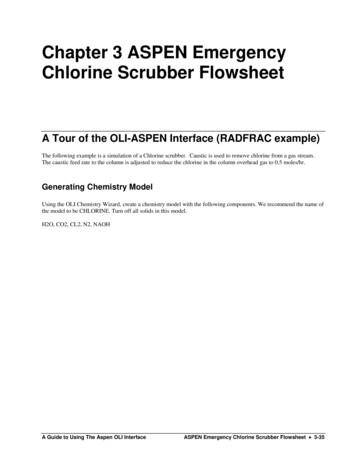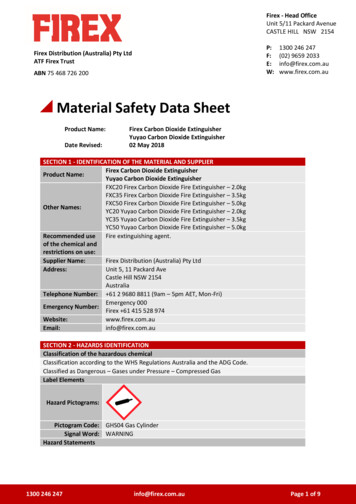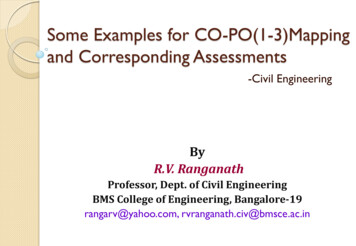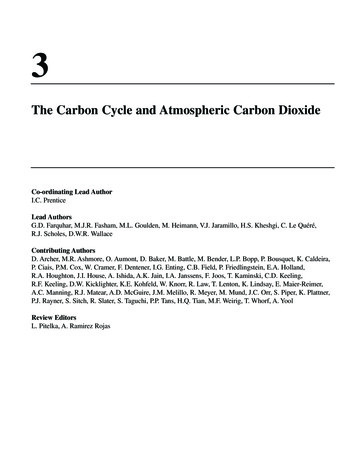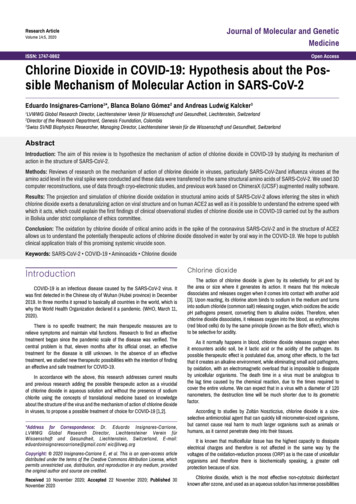
Transcription
Research ArticleVolume 14:5, 2020Journal of Molecular and GeneticMedicineISSN: 1747-0862Open AccessChlorine Dioxide in COVID-19: Hypothesis about the Possible Mechanism of Molecular Action in SARS-CoV-2Eduardo Insignares-Carrione1*, Blanca Bolano Gómez2 and Andreas Ludwig Kalcker3LVWWG Global Research Director, Liechtensteiner Verein für Wissenschaft und Gesundheit, Liechtenstein, SwitzerlandDirector of the Research Department, Genesis Foundation, Colombia3Swiss SVNB Biophysics Researcher, Managing Director, Liechtensteiner Verein für die Wissenschaft und Gesundheit, Switzerland12AbstractIntroduction: The aim of this review is to hypothesize the mechanism of action of chlorine dioxide in COVID-19 by studying its mechanism ofaction in the structure of SARS-CoV-2.Methods: Reviews of research on the mechanism of action of chlorine dioxide in viruses, particularly SARS-CoV-2and influenza viruses at theamino acid level in the viral spike were conducted and these data were transferred to the same structural amino acids of SARS-CoV-2. We used 3Dcomputer reconstructions, use of data through cryo-electronic studies, and previous work based on ChimeraX (UCSF) augmented reality software.Results: The projection and simulation of chlorine dioxide oxidation in structural amino acids of SARS-CoV-2 allows inferring the sites in whichchlorine dioxide exerts a denaturalizing action on viral structure and on human ACE2 as well as it is possible to understand the extreme speed withwhich it acts, which could explain the first findings of clinical observational studies of chlorine dioxide use in COVID-19 carried out by the authorsin Bolivia under strict compliance of ethics committee.Conclusion: The oxidation by chlorine dioxide of critical amino acids in the spike of the coronavirus SARS-CoV-2 and in the structure of ACE2allows us to understand the potentially therapeutic actions of chlorine dioxide dissolved in water by oral way in the COVID-19. We hope to publishclinical application trials of this promising systemic virucide soon.Keywords: SARS-CoV-2 COVID-19 Aminoacids Chlorine dioxideIntroductionCOVID-19 is an infectious disease caused by the SARS-CoV-2 virus. Itwas first detected in the Chinese city of Wuhan (Hubei province) in December2019. In three months it spread to basically all countries in the world, which iswhy the World Health Organization declared it a pandemic. (WHO, March 11,2020).There is no specific treatment; the main therapeutic measures are torelieve symptoms and maintain vital functions. Research to find an effectivetreatment began since the pandemic scale of the disease was verified. Thecentral problem is that, eleven months after its official onset, an effectivetreatment for the disease is still unknown. In the absence of an effectivetreatment, we studied new therapeutic possibilities with the intention of findingan effective and safe treatment for COVID-19.In accordance with the above, this research addresses current resultsand previous research adding the possible therapeutic action as a virucidalof chlorine dioxide in aqueous solution and without the presence of sodiumchlorite using the concepts of translational medicine based on knowledgeabout the structure of the virus and the mechanism of action of chlorine dioxidein viruses, to propose a possible treatment of choice for COVID-19 [1,2].*Address for Correspondence: Dr. Eduardo Insignares-Carrione,LVWWG Global Research Director, Liechtensteiner Verein fürWissenschaft und Gesundheit, Liechtenstein, Switzerland, E-mail:eduardoinsignarescarrione@gmail.com/ eic@lvwg.orgCopyright: 2020 Insignares-Carrione E, et al. This is an open-access articledistributed under the terms of the Creative Commons Attribution License, whichpermits unrestricted use, distribution, and reproduction in any medium, providedthe original author and source are credited.Received 10 November 2020; Accepted 22 November 2020; Published 30November 2020Chlorine dioxideThe action of chlorine dioxide is given by its selectivity for pH and bythe area or size where it generates its action. It means that this moleculedissociates and releases oxygen when it comes into contact with another acid[3]. Upon reacting, its chlorine atom binds to sodium in the medium and turnsinto sodium chloride (common salt) releasing oxygen, which oxidizes the acidicpH pathogens present, converting them to alkaline oxides. Therefore, whenchlorine dioxide dissociates, it releases oxygen into the blood, as erythrocytes(red blood cells) do by the same principle (known as the Bohr effect), which isto be selective for acidity.As it normally happens in blood, chlorine dioxide releases oxygen whenit encounters acidic soil, be it lactic acid or the acidity of the pathogen. Itspossible therapeutic effect is postulated due, among other effects, to the factthat it creates an alkaline environment, while eliminating small acid pathogens,by oxidation, with an electromagnetic overload that is impossible to dissipateby unicellular organisms. The death time in a virus must be analogous tothe lag time caused by the chemical reaction, due to the times required tocover the entire volume. We can expect that in a virus with a diameter of 120nanometers, the destruction time will be much shorter due to its geometricfactor.According to studies by Zoltán Noszticzius, chlorine dioxide is a sizeselective antimicrobial agent that can quickly kill micrometer-sized organisms,but cannot cause real harm to much larger organisms such as animals orhumans, as it cannot penetrate deep into their tissues.It is known that multicellular tissue has the highest capacity to dissipateelectrical charges and therefore is not affected in the same way by thevoltages of the oxidation-reduction process (ORP) as is the case of unicellularorganisms and therefore there is biochemically speaking, a greater cellprotection because of size.Chlorine dioxide, which is the most effective non-cytotoxic disinfectantknown after ozone, and used as an aqueous solution has immense possibilities
Insignares-Carrione E, et al.J Mol Genet Med, Volume 14:5, 2020of being used therapeutically since it is also capable of penetrating andeliminating biofilm, which ozone does not do [3]. The great advantage of thepossible therapeutic use of chlorine dioxide in infections is the impossibility of abacterial or viral resistance to ClO2 since it has an oxidation mechanism unlikechlorine (Cl2) which acts by chlorination [3].the SARS-CoV-2 [4] and SARS-CoV-2 coronavirus, such as the workcarried out at the University of Queretaro in Mexico and published inNovember 2020 COVID-19, called "In vivo evaluation of the antiviraleffect of ClO2 (chlorine dioxide) in chicken embryos inoculated withavian coronavirusAlthough ozone is stronger in antiseptic terms, its high oxidative potentialof 2.07 and its short half-life of only 15 minutes at 25 C with a pH value of 7.0makes it less effective than ClO2 for therapeutic applications in vivo. Chlorinedioxide is pH (-) and a size selective oxidant and, unlike other substances, itdoes not react with most components of living tissues (3). Chlorine dioxidereacts rapidly with phenols and thiols essential for bacterial life.(IBV), in which ClO2 treatment had a marked impact on IBV infection.Namely, viral titers were 2.4 times lower and mortality was halved in infectedembryos that were treated with ClO2. The infection caused developmentalabnormalities regardless of treatment. Lesions typical of IBV infections wereobserved in all inoculated embryos, but the severity tended to be significantlyless in ClO2-treated embryos. No macro or microscopic evidence of toxicitycaused by ClO2 was found at the doses used.In phenols, the mechanism consists in the attack of the benzene ring,eliminating odor, taste and other intermediate compounds [4]. Chlorine dioxidekills viruses effectively and is up to 10 times more effective than sodiumhypochlorite (bleach or bleach). It was also shown to be very effective againstsmall parasites, protozoa [5]. One topic that has been reviewed a lot latelyis the reactivity of chlorine dioxide with amino acids. In tests for reactivity ofchlorine dioxide with 21 amino acids, only cysteine [4], tryptophan [5], tyrosine[6], proline and hydroxyproline reacted at a pH of around 6.Cysteine and methionine (4) are two aromatic amino acids that containsulfur, tryptophan and tyrosine and the two inorganic ions Fe2 and Mn2 [3].Cysteine, because it belongs to the group of thiols, is an amino acid up to50 times more reactive with all microbial systems than the other four aminoacids and, therefore, it is impossible for it to create resistance against chlorinedioxide.The hypothesis we propose here is that the cause of the antiviral effect ofchlorine dioxide can be explained by its actions on at least five amino acidslisted above or on peptide residues.Chlorine dioxide (ClO2) has been used since 1944 in the treatment ofdrinking water due to its biocidal power, as well as in most bottled waterssuitable for human consumption due to its almost zero lack of toxicity in anaqueous solution being used systematically in the disinfection and conservationof blood transfusion bags [3,4]. As it is a selective oxidant, its mode of action isvery similar to that of phagocytosis, where a mild oxidation process is used toeliminate all types of pathogens [3,4].Chlorine dioxide (ClO2) is a yellowish gas that to date is not part of theconventional pharmacopoeia as a medicine despite its proven effectiveness indenaturing viruses, with multiple patents for use in different treatments such asdisinfection or sterilization of blood components (blood cells, blood proteins,etc.) 4, the parenteral treatment (intravenous route) of HIV infections, or forthe treatment of neurodegenerative diseases such as amyotrophic lateralsclerosis (ALS), Alzheimer's and other patents for uses such as patents for:apoptosis induction cancer treatment (CN 103720709 A) tumor treatment (US10, 105, 389 B1) Sinusitis antiviral treatment (US 2o16/0074432 A1), Systemstimulation immunological (US 5,830,511),Stem cell initiation and differentiation(WO2014082514A1), Vaginal treatment method (US 6280716B1), Skintreatment against viruses and bacteria (US 4,737,307), Human amoebiasistreatment method (US 4,296,102), Treatment against candidiasis infections ( US2015/0320794 A1), Wound treatment (US 87.3106), Oral cavity treatment (US100015251), (US4689215), Against inflammations (US53841134), Nail fungustreatments (US 20100159031) and Against inflammations (US53841134),Treatments against nail fungus (US 20100159031) and Against inflammations(US53841134), Treatments against nail fungus (US 20100159031) and Swisspatent pending/11136-CH. (Kalcker, A.) 1. Chlorine dioxide can fight viruses through the selective oxidationprocess by denaturing capsid proteins and subsequent oxidation of thevirus's genetic material, rendering it disabled. As there is no possibleadaptation to the oxidation process, it prevents the development ofresistance by the virus, making chlorine dioxide (ClO2) a promisingtreatment for any viral subspecies.2. There is scientific evidence that chlorine dioxide is effective againstPage 2 of 83. Toxicity: The biggest problems that arise with drugs or substances thatcan be considered as such in general are due to their toxicity and sideeffects. There is toxicity with chlorine dioxide in case of respiratoryinhalation, but there are no reports of toxicity at the recommendeddose of 30 mg or 30 ppm in aqueous solution when taken orally andno clinically proven death even at high doses by oral ingestion. Thelethal dose (LD50, acute toxicity ratio) is estimated at 292 mg per kilofor 14 days, where its equivalent in a 50 kg adult would be 15,000 mgadministered over two weeks. The sub-toxic oral doses that can beused are approximately 50 ppm dissolved in 100 ml of water 10 timesa day, which is equivalent to 500 mg. Furthermore, chlorine dioxide,by dissociation, it decomposes into a chlorine ion that immediatelyassociates with the sodium ion, forming common salt NaCl andoxygen O2 within the human body. In summary, chlorine dioxide atthe recommended doses in COVID-19 of 30 mg or 30 ppm per day isnot toxic [5-8].Virucidal effects of chlorine dioxideChlorine dioxide is an effective antimicrobial agent that kills bacteria,viruses, and some parasites [9]. Its broad spectrum germicidal profile isderived from the action of this compound as a non-cytotoxic oxidant.Viruses generally consist of an outer layer or a protein coat thatencapsulates a nucleic acid, which can be DNA or RNA. When chlorine dioxidecomes in contact with a virus, a single, highly reactive nascent oxygen atomis released on the target virus. This oxygen binds to specific amino acids inthe protein coat of the virus, denaturing the proteins and rendering the virusinactive. Additionally, nascent oxygen atoms bind to guanine, one of thefour nucleic acid bases found in RNA and DNA, forming 8-oxoguanine. Thisoxidation of guanine residues prevents viral nucleic acid replication [10].In the published scientific literature there are reports that chlorine dioxideinactivates a wide variety of viruses, including influenza A, human adenovirus,human rotavirus, echovirus, bacteriophage f2, and poliovirus [11-16].Influenza A viruses are spherical, negative-sense, single-stranded RNAviruses that possess a lipid membrane that contains peaks composed ofglycoproteins known as HA (hemagglutinin) and NA (neuraminidase). Withinthe virus there are eight single strands of RNA [17]. A preclinical study foundthat chlorine dioxide gas is effective in preventing aerosol-induced influenza Avirus infection. This study used low concentrations of chlorine dioxide gas (ie0.03 ppm) in a mouse cage. This level is below the OSHA long-term exposurelevel (8 hours) for chlorine dioxide gas in ambient air in a human workplace,which is 0.1 ppm [18]. Chlorine dioxide gas effectively reduced the number ofinfectious viruses in the lungs of mice and markedly reduced mortality. Mortalitywas 70% (7/10) on day 16 in the group not treated with chlorine dioxide and 0%(0/10) in the group treated with chlorine dioxide. The authors confirmed theseresults by repeating their experiment. The results of the repeat study were50% (5/10) mortality in the untreated group and 0% (0/10) in the treated group.The authors concluded that low levels of chlorine dioxide gas (i.e., 0.03ppm), which are below the permissible exposure level in human workplaces,"could be used in the presence of humans to prevent their infection by influenzaA virus and possibly other viruses associated with tract infections respiratory(p. 65). They suggested that "chlorine dioxide gas could be used in places
Insignares-Carrione E, et al.J Mol Genet Med, Volume 14:5, 2020like offices, theaters, hotels, schools and airport buildings without evacuatingpeople, without disrupting their normal activities." The authors suggested thattheir method "opens a new path for the prevention of pandemic influenza" (p.65) after conducting a study in a school with favorable results in this regard.The infectivity of the virus was found to be reduced in vitro by theapplication of chlorine dioxide, and higher concentrations produce evengreater reductions. This inhibition of infectivity was correlated with alterationsin viral proteins. These alterations resulted from the incorporation of oxygenatoms in the tryptophan and tyrosine residues located in the HA and NAproteins [11]. These proteins are denatured by the addition of oxygen atoms,which eliminates the ability of the virus to infect other cells [19]. A later studyfound that influenza A virus inactivation is caused by the transfer of 2 oxygenatoms from chlorine dioxide to a specific tryptophan (W153) residue in thehemagglutinin (HA) tip protein [20].Adenoviruses are non-enveloped viruses with an icosahedral capsidcontaining a double-stranded DNA genome. Seven groups of humanadenoviruses have been classified [21]. A recent study found that chlorinedioxide can help reduce adenovirus levels in drinking water [12]. This studyexamined the effects of chlorine dioxide and ultraviolet light on adenoviruslevels in drinking water in the Netherlands. The authors found that theapplication of chlorine dioxide in low concentrations (0.05 - 0.1 ppm) reducedadenoviruses in drinking water, while UV disinfection was insufficient withoutchlorine dioxide disinfection.Rotaviruses are double-stranded RNA viruses that consist of 11 uniquedouble-stranded RNA molecules surrounded by a three-layered icosahedralprotein capsid [22]. These viruses, which are the leading cause of severediarrheal diseases in infants and young children worldwide, are inactivated bychlorine dioxide. In fact, at concentrations of chloride dioxide ranging from 0.05to 0.2 ppm, they are inactivated within 20 seconds in vitro [23,24].Bacteriophage f2 is a positive sense single-stranded RNA virus that infectsEscherichia coli bacteria. An in vitro study found that 0.6 mg/liter of chlorinedioxide rapidly (i.e., within 30 seconds) inactivated bacteriophage f2 andinterfered with its ability to bind to its host, E. coli [15]. Both the inactivation ofthe virus and the inhibition of its ability to bind to its host increased with higherpH and with increasing concentrations of chlorine dioxide. Additionally, theauthors found that chlorine dioxide denatures virus capsid proteins by reactingwith tyrosine, tryptophan, and cysteine residues. These amino acids werealmost completely degraded within 2 minutes of exposure to chlorine dioxide.Poliovirus is a positive-sense, positive-strand RNA virus [25]. Ridenourand Ingerson found that chlorine dioxide can inactivate polio virus in vitro.Later, Álvarez and O'Brien expanded this work by showing that treatment with1 ppm of chlorine dioxide in vitro results in the separation of RNA from thecapsid and also produces alterations in the RNA [16,26].In addition to the studies mentioned above, the US EnvironmentalProtection Agency (EPA), which on April 10, 2020 listed chlorine dioxide as anEPA-registered disinfectant to kill the SARS-CoV-2 virus, provides additionalsupport for the virucidal effects of chlorine [27]. The EPA website indicates thatthis product is for surface use and not for human use.Human studies on the effects of chlorine dioxide on the SARS-CoV-2 virushave not yet been conducted. Currently, two of the authors (Insignares andBolano) are conducting the first multicenter clinical trial in the world on theeffectiveness of oral chlorine dioxide in humans in COVID-19 (ClinicalTrials.gov identifier: NCT04343742). An in vitro study found that chlorine dioxideinactivates the genetically related SARS-CoV-2virus [28]. A concentration of2.19 mg/liter of chlorine dioxide was found to cause complete inactivation ofSARS-Co-V in wastewater. A branch of our group is in the process of conductingan in vitro investigation of the action of chlorine dioxide on SARS-CoV-2 inIndia and we are in the process of publishing a report on the simulation of themechanism of action of chlorine dioxide in SARS-Co-V-2 using the in silicomethod, carried out in Japan.In Ecuador (Aememi) for Chlorine dioxide, an effective therapy forthe treatment of COVID-19; 51) A preliminary trial was carried out with theadministration of oral chlorine dioxide on 104 COVID-19 patients whohad variable profiles in terms of age, sex and severity of the disease, theminority diagnosed by testing and the majority by screening according totypical symptoms of the illness. Therefore, the data were managed using asymptomatic scoring scale, with 10 being the maximum perception and 0 beingthe minimum of the symptom: fever, chills, muscle pain, dry cough, headache,back pain, difficulty breathing, vomiting, diarrhea, sore throat, loss of smell,loss of taste, poor appetite.Chlorine dioxide in a concentration of 3000 ppm was recommended at adose of ten cc diluted in one liter of water, taken throughout the day, dividedinto 10 daily doses, taken every hour and a half for 20 days. The results weredistributed according to the symptoms after the first, second, third and fourthtreatment days. They were segmented between men and women, and commonresults were also presented. The following tables show the symptoms, and inthe first and last graph the behavior in relation to the symptomatological scalebetween the first and fourth day of oral chlorine dioxide intake (Figures 1-4).From this preliminary study the following conclusions can be drawn:Chlorine dioxide is definitely harmless - not toxic at all - in the recommendedFigure 1. The structural differences between the RBMs of SARS-CoV-2 and SARS-CoV.Page 3 of 8
Insignares-Carrione E, et al.J Mol Genet Med, Volume 14:5, 2020Figure 2. Three-dimensional structure of SARS-CoV-2 Mpro in two different views.Figure 3. Results of chlorine dioxide on day 1 of its administration.and ingested doses and all initial symptoms began to decrease from thefirst day of treatment, the decrease being totally evident on the fourth day.Specifically, symptoms most indicative of an ongoing infection, such as fever,chills, headache, sore throat, loss of appetite, and loss of the senses of tasteand smell, were dramatically decreased. Other symptoms, such as musclepain and cough, remained somewhat common, as they tend to remain residualfor longer after the illness has ended.April 2020, finding the following results: 1. PubMed (Medline): 4 references, 2.LILACS: 18 references, 3. Cochrane Library: 56 references, 4. Science: 1,168references, 5. Scielo: 61 references, 6. MedScape: 19 references for a totalof 1,326 scientific publications whose contents were on the use of chlorinedioxide in different applications and on the mechanism of action of chlorinedioxide in the SARS-CoV-2 viruse. Finally, we reviewed the registries at www.clinicaltrials.gov and those of the WHO International Clinical Trials RegistryPlatform (ICTRP) in order to identify ongoing or unpublished clinical trials.Materials and MethodsSearch strategyTo search for the reference information used in this article, the web searchengines were reviewed using the MesH criteria, in accordance with the searchstrategy indicated in subsequent lines in the periods between January andPage 4 of 8"Chlorine dioxide" OR "Chlorine dioxide protocol" OR Chlorine dioxide ANDvirus; Chlorine dioxide AND SARS-COV-2; OR "COVID-19 drug treatment" OR"spike glycoprotein, COVID-19 virus" OR "severe acute respiratory syndrome
Insignares-Carrione E, et al.J Mol Genet Med, Volume 14:5, 2020Figure 4: Results of chlorine dioxide on day 4 of its administration.coronavirus 2" OR "COVID-19" OR "2019-nCoV" OR "SARS-CoV-2" O " 2019new coronavirus "OR" 2019 coronavirus disease "OR (pneumonia).capable of reacting with ClO2 as well as with free amino acids, the inactivationof the virus can be extremely rapid even in a solution of 0.1 mg/L of ClO2.From the search results, we selected those that made reference to thevirucidal action of chlorine dioxide on various microorganisms, in particular onviruses and, among these, SARS-CoV-2 or SARS-CoV.On the other hand, we selected the articles that describe the action ofSARS-CoV-2 in cells, in its interaction with ACE2 and, in particular, weinvestigated augmented reality videos or simulation videos based on Silico,for three-dimensional representation. From action sites like videos in which thespicular protein and the ACE2 receptor, among others, are manipulated withChimeraX (UCSF) augmented reality software [34-41].We also reviewed the studies carried out on the action of chlorine dioxideon amino acids, especially those that are part of viral capsids. From the findingswe highlight that in 1986, Noss et al. demonstrated that the inactivation ofbacterial virus (bacteriophage) f2 by ClO2 was due to its reactions with viralcapsid proteins. Additionally, they found that three amino acids of the viralprotein, namely cysteine, tyrosine and tryptophan, could react with ClO2 rapidly[15]. In 1987, Tan and others tested the reactivity of ClO2 at 21 free amino acids[29]. The ClO2 reacted with only six amino acids dissolved in 0.1 M sodiumphosphate buffer at pH 6.0. The reaction with cysteine, tryptophan and tyrosinewas too rapid to be followed by his technique.The reactivity of the three fast-reacting amino acids (cysteine, tyrosineand tryptophan were studied in the laboratory between 2005 and 2008, findingthat cysteine had the highest reactivity among these three amino acids [30,31].In 2007, Ogata discovered that the antimicrobial activity of ClO2 is basedon the denaturation of certain proteins, which is mainly due to the oxidativemodification of the tryptophan and tyrosine residues of the two model proteins(bovine serum albumin and glucose - 6- phosphate dehydrogenase) used intheir experiments [32]. In 2012, it was again Ogata who demonstrated that theinactivation of the influenza virus by ClO2 was caused by the oxidation of atryptophan (W153) residue into hemagglutinin (a protein from the spike of thevirus), thus suppressing its ability to bind to receptors [20].In this context, it is interesting to note that the spike protein of the newcoronavirus SARS-CoV-2 contains 54 tyrosine residues, 12 tryptophan and40 cysteine [33].If we assume that in an aqueous solution all these amino acid residues arePage 5 of 8In the same way, we reviewed the structure of the virus spike and basedon research from Daniel Wrapp and Jason S. McLellan at the University ofTexas.The three-dimensional image of the spicular S glycoprotein of the SARSCoV-2 betacoronavirus has been seen with electron cryomicroscopy in recordtime. Thanks to this image with a resolution of 3.5 Å, it is confirmed thatthis S protein is coupled to the hACE2 protein of human cells with a higheraffinity than that of the SARS-CoV-2coronavirus. Protein S is the target of theantibodies that immunize us. Its 3D structure makes it possible to understandwhy published monoclonal antibodies against SARS-CoV-2are not effectiveagainst SARS-CoV-2. It will undoubtedly help accelerate the development ofvaccines and therapies against COVID-19 infection [42].In these simulation and virtual reality videos, it is observed that protein Sis a trimer made up of three peptides, each with two subunits S1 and S2. TheS1 subunit acts as a hinge with two conformations called "down" (RBD down)and "up" (RBD up). Electron cryomicroscopy imaging shows that only one ofthe peptides is in the "up" state, while the other two are in the "down" state.Binding to the cellular receptor occurs in the "upstream" configuration. Afterbinding, the three protein S peptides are cleaved at the S1/S2 site; a secondsplit then occurs at the S2 'point, unfolding the key fusion peptide (FP) at thejunction between the membranes.The spicular protein (S) is a type I transmembrane trimeric protein withbetween 1,160 and 1,400 amino acids, depending on the type of coronavirus.
Insignares-Carrione E, et al.This protein forms the coronavirus corona; It is composed of three repeatingpeptides and is highly glycosylated, which facilitates its binding to proteins andsugars. Each peptide is made up of two domains called S1 and S2. In betacoronaviruses like SARS-CoV-2, cleavage of the S1 and S2 subunits occursduring fusion between the membranes.The S1 domain has two subdomains, one N-terminal (NTD), which endswith an amino acid that has a free amino group (-NH2), and another C-terminal(CTD), which ends with a carboxyl group (-COOH); both bind to the host cell'sACE2 receptor, then they are receptor-binding domains (RBD). The S2 domainis C-terminal in type and is highly conserved among all coronaviruses, whichdiffer much more in the S1 subunit. The S2 domain contains two regions, HR1and HR2, in which groups of seven amino acids (called heptides) repeat, inabcdefg form, that contain a and d hydrophobic residues that participate in thefusion between the membranes. The HR1 and HR2 domains are therapeutictargets, since drugs are known that inhibit their action, preventing or hinderingfusion.The infection of the epithelial cells of the respiratory tract is orchestratedby the S protein of the virus. In the general steps of the fusion process first,the S1 domain recognizes and binds to the host cell receptor. Second, thereis a first split at the S1 and S2 domains, and a second split at the S2 'point;the latter allows the fusion peptide (FP) that connects the membranes of thehost and the virus to be activated (this stage is called the intermediate stageof fusion or intermediate stage of fusion). And third, the region between HR1and HR2 remodels (folds) giving rise to a heptamer (6-HB) that joins bothmembranes allowing the entry of the virus.The S protein of coronaviruses is key in the development of vaccines(antigens that induce an immune response to the presence of the S1 domain)and for the development of antivirals (inhibitors of some of the fusion stagesbetween membranes, normally attacking specific regions of the domain S2).Knowing the three-dimensional structure of protein S is essential to combat theCOVID-19 epidemic.The sequence of the protein S of SARS-CoV-2 coincides 98% with theprotein S of the coronavirus Bat-RaTG13, with the great difference that it hasfour RRAR amino acids (arginine-arginine-alanine-arginine) instead of just onearginine (R). Furthermore, they differ in 29 residues, 17 of which are in theRBD region. The comparison made between the 61 complete SARS-CoV-2genomes available in GISAID (Global Initiative to Share All Influenza Data)shows that there are only 9 different amino acids between all of them; and allthese variants are found in very well preserved places, which does not seem toaffect the lethality of the coronavirus.First, it was possible to characterize the 3D structure of the spicular Sglycoprotein of the SARS-CoV-2 coronavirus and its RBD receptor bind
ISS: 14-2 Open Access ournal of Molecular and Genetic Medicine Research Article Volume 14:5, 2020 Abstract Introduction: The aim of this review is to hypothesize the mechanism of action of chlorine dioxide in COVID-19 by studying its mechanism of action in the structure of SARS-CoV-2. Methods: Reviews of research on the mechanism of action of chlorine dioxide in viruses, particularly SARS-CoV .
